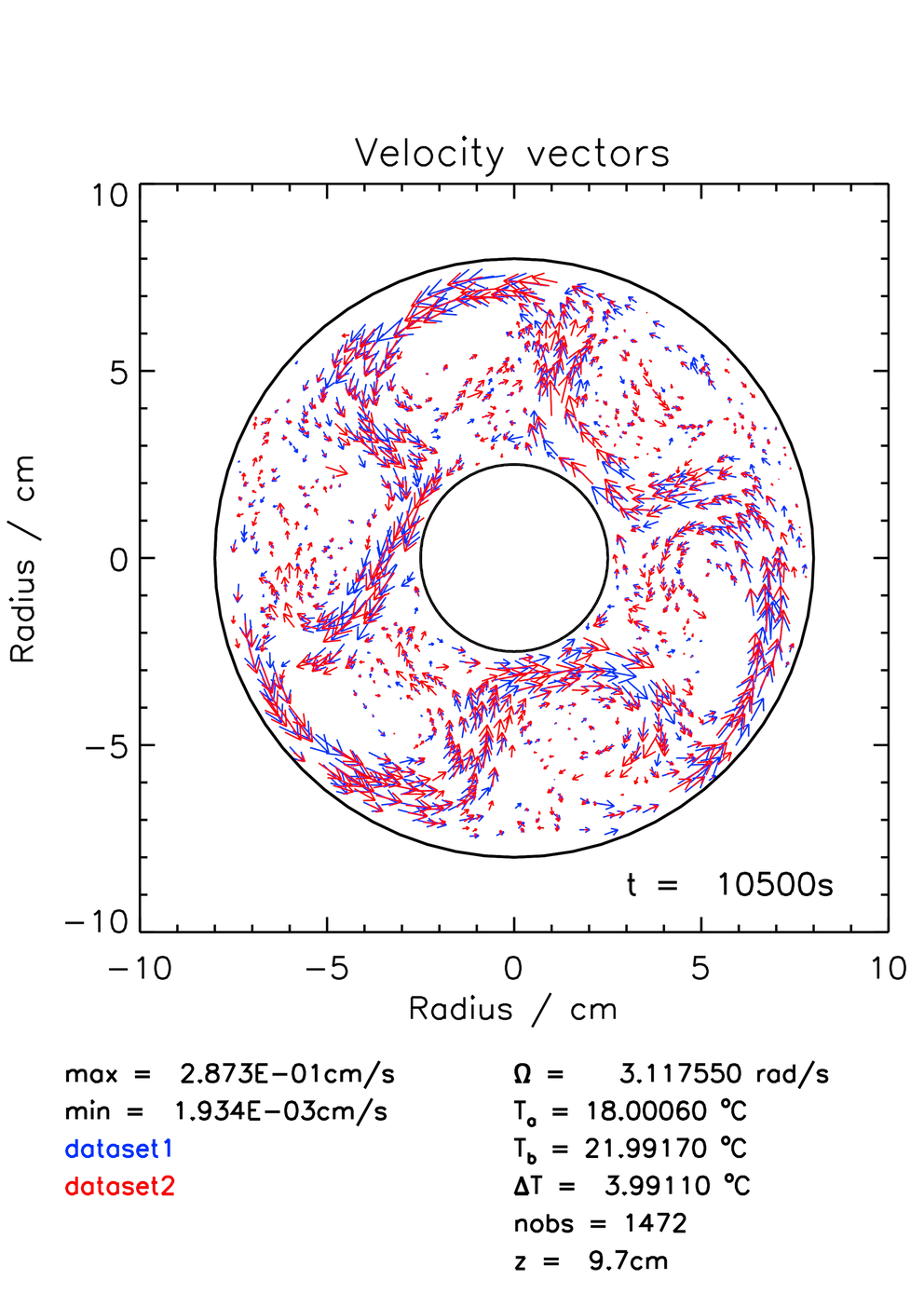Mars reanalyses assimilating EMM-EMIRS profiles during MY36
This dataset contains a sequence of 633 complete atmospheric states for Mars’ atmosphere during Mars Year 36, between sols-of-year 121–200, described in Young et al. (2022b). These were created by assimilating atmospheric temperature observations from EMM-EMIRS between MY36 Ls = 57.42–92.97° into the Mars PCM using the LETKF.
The dataset is available HERE, along with a more complete description.
Citation: R. M. B. Young, E. Millour, F. Forget, M. D. Smith, M. Aljaberi, C. S. Edwards, N. Smith, S. Anwar, P. R. Christensen, and M. J. Wolff (2022), "Dataset accompanying 'First assimilation of atmospheric temperatures from the Emirates Mars InfraRed Spectrometer'", EMM Science Data Center. Link.
This dataset contains sequences of 577 complete atmospheric states for Mars' atmosphere during Mars Year 34 between Ls = 182.3–211.4°, described in Young et al. (2022a). These were created by assimilating atmospheric temperature profiles and dust column opacity observations from ExoMars TGO-ACS-TIRVIM into the Mars PCM using the LETKF.
The dataset is available HERE, along with a more complete description, and is licensed under CC BY 4.0 International.
Citation: R. Young, E. Millour, S. Guerlet, F. Forget, N. Ignatiev, A. Grigoriev, A. Shakun, A. Trokhimovskiy, F. Montmessin, and O. Korablev (2022), "Mars atmosphere reanalyses during the MY34 Global Dust Storm produced by assimilation of ExoMars TGO-ACS-TIRVIM observations into the Mars PCM using the LETKF", figshare. doi:10.6084/m9.figshare.20709451.v1
This dataset contains reanalyses from assimilating MCS dust profiles and THEMIS dust column opacities into the UK version of the LMD Mars GCM using Analysis Correction, described in Ruan et al. (2021). The dataset covers Mars Years 28-29.
The dataset is available HERE, along with a more complete description, and is licensed under CC BY 4.0 International.
Citation: Tao Ruan, R. M. B. Young, S. R. Lewis, L. Montabone, A. Valeanu, and P. L. Read (2021), "A vertically-resolved atmospheric dust reanalysis for Mars Years 28-29 using Analysis Correction [data set]", Zenodo. doi:10.5281/zenodo.5517308
This dataset contains model output from the Saturn DYNAMICO simulations described in Cabanes et al. (2020).
We use a high performance Global Climate Model, DYNAMICO, to model the atmospheric circulation of gas giants with appropriate physical parametrizations for Saturn's atmosphere. The model solves the 3D primitive equations of motion. We ran a simulation covering 15 Saturn years. Wind fields are output every 20 Saturn days at 32 pressure levels onto a 0.5-degree latitude-longitude grid.
The dataset is available HERE, and is licensed under CC BY 4.0 International.
A more complete description of the dataset can be found in the dataset Readme PDF.
Citation: S. Cabanes, A. Spiga, & R. M. B. Young (2020) "JUMP - Data collection - Part I: Jets from a Global Climate Model [data set]", Zenodo. doi:10.5281/zenodo.3638105.
This dataset contains model output from the simulations used in Jupiter GCM papers Part I and Part II. It contains instantaneous model states from two simulations, generated by a version of the MIT General Circulation Model modified to simulate Jupiter’s upper troposphere and lower stratosphere. The MITgcm is available from https://mitgcm.org. A complete description of the Jupiter model is in Part I, except for the cloud scheme, which is in Part II.
The data are instantaneous snapshots of the flow fields from two simulations, covering a period of 100 d with snapshots every 20 d. Run A has no heat flux into the bottom of the domain, and Run B has 5.7 W m−2 heat flux into the bottom of the domain. The fields included are zonal velocity, meridional velocity, vertical velocity in pressure coordinates, potential temperature, and mass mixing ratios for ammonia (gas, solid), hydrogen sulphide (gas), ammonium hydrosulphide (solid), and water (gas, liquid, solid).
The dataset is available HERE, and is licensed under ODC-By v1.0.
A more complete description of the dataset can be found in the dataset Readme PDF.
Citation: R.M.B. Young, P.L. Read, & Y. Wang (2018) "Simulating Jupiter’s weather layer: Accompanying data for Parts I and II", Oxford University Research Archive. doi:10.5287/bodleian:PyYbbxpk2.
This dataset contains horizontal wind velocity vectors at the top of Jupiter’s main cloud deck, covering four rotation periods during December 2000. These wind measurements are based on a series of visible camera images taken by NASA’s Cassini spacecraft. They were analysed using a cloud tracking procedure based on a Correlation Imaging Velocimetry method developed to analyse fluid dynamics experiments. The dataset contains 1123505 horizontal wind velocity vectors covering 360 degrees in longitude and +/-50 degrees in planetocentric latitude. The dataset also includes a Python script to convert the velocity vectors from spherical geometry to oblate spheroidal geometry, and to estimate observational uncertainties.
This dataset was the basis for the structure function analysis and some of the spectral flux analysis in Young & Read (2017) on kinetic energy cascades in Jupiter's atmosphere. We used a slightly different version of this dataset in Galperin et al. (2014) and that dataset is available as supplementary material to that paper.
The dataset is available HERE, and is licensed under ODC-By v1.0.
A more complete description of the dataset can be found in the dataset Readme PDF.
Citation: R.M.B. Young, P.L. Read, D. Armstrong, & A.J. Lancaster (2017) "Jupiter horizontal wind velocities at cloud level from Cassini", Oxford University Research Archive. doi:10.5287/bodleian:D5oVPJVRv.
The thermally-driven rotating annulus: horizontal velocities in regular and weakly chaotic flow regimes 
This dataset contains 11 1/2 hours of horizontal velocity measurements from four experiments using AOPP's "small annulus" thermally-driven rotating annulus laboratory experiment. The experiments cover regular (2S, 3AV, two experiments) and weakly chaotic (3SV, two experiments) flow regimes. The apparatus consists of two concentric right circular cylinders with height 14.0cm and radii 2.5cm and 8.0cm, with a 17% glycerol / 83% water mixture (by volume) between them. The outer cylinder is heated and the inner cylinder cooled relative to the working fluid, with a temperature difference of approximately 4K, and the apparatus rotates about the co-incident axis of the two cylinders at rates between 0.75 and 3.1 rad/s. This setup mimics the main effects acting on a planetary atmosphere: gravity, rotation, and a heating gradient between low and high latitudes.
The experiments were originally run in 1998. This dataset was put together after using the measurements during my DPhil work on assimilation and predictability in the rotating annulus. My papers using this dataset are Young & Read (2013) and Young & Read (2016).
The dataset is available HERE, and is licensed under ODC-By v1.0.
A more complete description of the dataset can be found on the Oxford GPFD group webpage HERE, and in the dataset Readme PDF.
Citation: R.M.B. Young, P.L. Read, W-G. Früh, D. Smith, & S.H. Risch (2015) "The thermally-driven rotating annulus: horizontal velocities in regular and weakly chaotic flow regimes", Oxford University Research Archive. doi:10.5287/bodleian:dr26xx49n.


